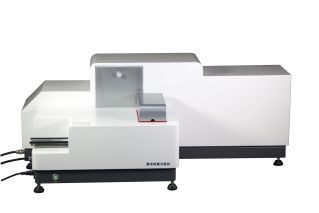March 06, 2025
Tag:
c
There are many methods to measure particle size distribution, including sieving, sedimentation, resistance, microscopic image and laser scattering. In the field of cement particle size measurement, screening method and laser scattering method are widely used. However, the screening method has limited resolution when measuring particles smaller than 60μm. Laser scattering method is favored by cement production enterprises by virtue of its advantages of simple and fast operation and accurate measurement. The principle is that the monochromatic coherent beam emitted by the light source is irradiated to the sample particles through the beam expanding mirror and Fourier lens, causing scattering phenomenon. The scattered light is projected on a series of photodetectors, and its energy distribution is closely related to the particle size distribution. The particle size distribution information of the sample can be obtained by inversion operation. JH series laser particle size meter from Shanghai Jiahang Instrument Co., Ltd. is suitable for the particle size measurement of various powders, suspensions and emulsions, providing a reliable particle size detection solution for the cement industry.
2. Experiment preparation
2.1 Test equipment

JH series laser particle size meter (specific models can be selected according to actual needs, such as JH-800 for large cement enterprises with high precision requirements, JH-600 is more suitable for small and medium-sized enterprises). This series of instruments has advanced optical systems and data processing algorithms to ensure the accuracy and stability of measurement results.
2.2 Experimental raw materials
Cement, anhydrous ethanol, pure water, etc. Anhydrous ethanol is often used as a dispersion medium to measure cement particle size because it can avoid the hydrolysis reaction of cement in water. Purified water plays a role in some specific experimental links or equipment cleaning.
3. Experimental steps
3.1 Test Method
Considering the hydrolysis property of cement in water, it is recommended to choose anhydrous alcohol as dispersing medium for wet measurement of cement particle size. If the enterprise has special needs, it can also use dry measurement. This scheme takes JH series laser particle size meter (wet method) as an example.
3.2 Measurement Procedure
Add dispersion medium: Add an appropriate amount of anhydrous ethanol to the sample pool of the instrument to ensure that the amount of dispersion medium meets the requirements of the instrument, and provide a good environment for subsequent sample dispersion.
Open the sample cycle: start the sample cycle system to make the dispersion medium flow fully in the system to achieve a stable state and ensure the consistency of the measurement environment.
Start the baseline measurement: Perform the baseline measurement to obtain the background data of the current dispersion medium, provide a reference for subsequent measurements, and eliminate systematic errors.
Close the sample cycle: After the baseline measurement is completed, close the sample cycle and prepare to add the measurement material.
Add measuring material: accurately weigh a certain amount of cement sample and slowly add it to the sample pool to avoid sample agglomeration or agglomeration and ensure that the sample is evenly dispersed in the dispersion medium.
Stirrer operation: Turn on the stirrer, stir the mixture of sample and dispersion medium at the appropriate speed, so that the cement particles are fully dispersed and the agglomeration phenomenon between particles is reduced.
Ultrasonic operation: Start the ultrasonic device, and use the cavitation effect of ultrasonic to further disperse the cement particles to ensure the accuracy of measurement.
Open the sample cycle: Open the sample cycle again so that the evenly dispersed sample flows steadily through the system and is ready for measurement.
Random read number: During the measurement process, multiple measurement data are read randomly to improve the reliability and representativeness of the measurement results.
End of measurement: The measurement operation is terminated after sufficient times of measurement are completed.
Data recording: accurately record the measured data, including the parameters of particle size distribution, such as D10, D50, D90, etc.
Open the drain: After the measurement, open the drain valve to drain the dispersion medium and sample mixture in the sample pool.
Automatic cleaning: Start the automatic cleaning function of the instrument to clean the sample pool, pipes and other components to prepare for the next measurement.
4. Results and discussion
4.1 Results
Through the measurement of JH series laser particle size meter, the particle size distribution data of cement samples can be obtained, such as: D10 = 3.5-4.5μm (specific values vary by sample), D50 = 16-18μm, D90 = 40-45μm and so on. At the same time, the differential and cumulative percentage data of particle size distribution can be obtained to visually show the particle distribution in different particle size intervals. These data can be generated by the software of the instrument to generate detailed particle size analysis report and particle size distribution map, which is convenient for enterprise analysis and research.
4.2 Discussion
Cement particle composition is closely related to cement strength. Particles with particle size below 1μm will be completely hydrated during the mixing process, although it does not contribute to strength, it will increase the water requirement at the time of pouring and affect the construction performance of cement. When the particle content of 1-3 μm is higher, the cement strength can be improved for 3 days, but the water requirement will also increase. The particle content of 1-32 μm determines the 28-day strength of the cement, and the higher the particle content in the interval, the better, while ensuring other properties. If there is a large surplus of strength indicators, enterprises can appropriately increase the amount of mixed materials to reduce costs while ensuring product quality. 32-65 μm particles have a certain contribution to the strength, but the contribution rate is relatively low. The particles above 65μm only act as a skeleton, and have no obvious help for strength improvement.


Contact Us
Tel: (+86) 400 610 1188
WhatsApp/Telegram/Wechat: +86 13621645194
+86 15021993094
Follow Us:




 Pharma Sources Insight July 2025
Pharma Sources Insight July 2025


